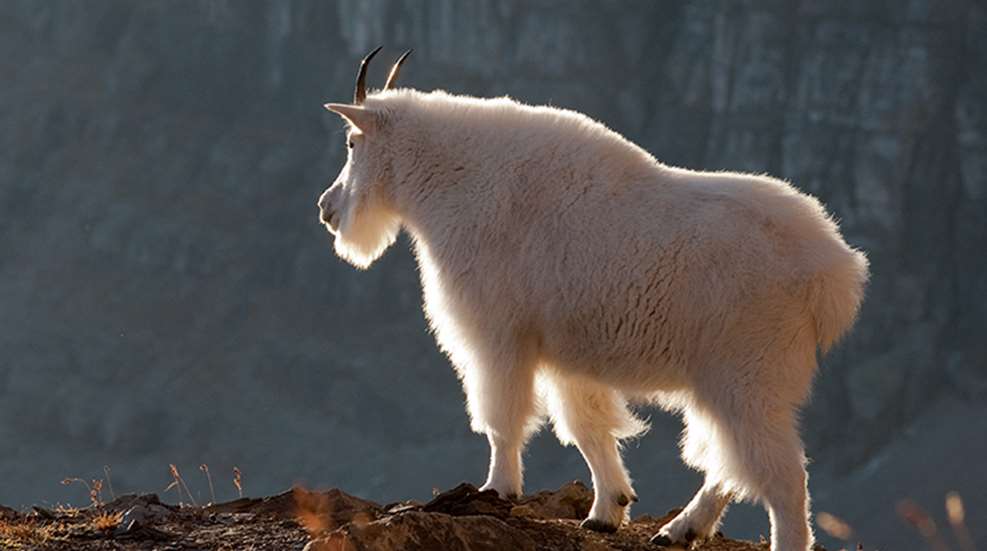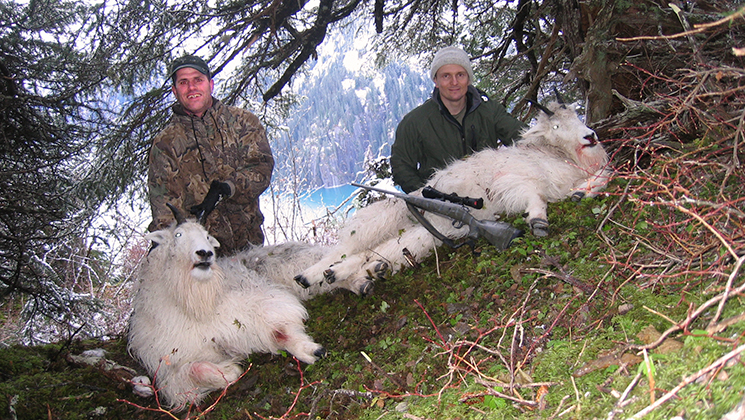
When conservationist John Muir explored the Tracy Arm fjord in 1880 he traveled in a dugout canoe with Tlingit guides. His description of the icy inlet, published in Travels in Alaska, is still among my favorites. Referring to Tracy Arm as “a wild, unfinished Yosemite,” Muir went on to write: “the drainage of fifty [glaciers] or more pours into this fjord. The water spaces between the bergs were as smooth as glass, reflecting the unclouded sky, and doubling the ravishing beauty of the bergs as the sunlight streamed through their innumerable angles in rainbow colors.”
Situated about 45 miles south of Juneau, Tracy Arm is also known for its world-class mountain goat hunting. In fact, Muir mentions Tlingits hunting goats in Tracy Arm “with spears, chasing them with their wolf-dogs.” So it was no surprise to my wife that the Arm was one of the first places I wanted to explore when we moved to Alaska. Traveling up the narrow, 30-plus-mile inlet that August, we were overwhelmed by the jade-colored water, the quantity of icebergs and the sheer rock walls rising close to 4,000 feet on either side of us. But from a hunter’s perspective, it was also intimidating. We saw goats at the highest elevations, but I had no idea how to get anywhere near them. It would be a year before I qualified for the Alaska residency that is required to hunt goats unguided. In the meantime, I had some “homework” to do.
Over the next several months, I learned a great deal from other hunters and the biologists at the Alaska Department of Fish and Game office in Juneau. Perhaps the most important detail was that, when the snow begins to fall, the goats in Tracy Arm move down the mountains to spend winter in the drainage areas Muir described in the earlier quote. And while the glaciers have receded considerably since Muir’s time, the drainages still exist as pockets of Southeast Alaska rainforest nested in the granite walls that line Tracy Arm. A few of these drainages extend all the way to the water’s edge, though far more of them are situated in the rocks at elevations between 500 and 2,000 feet.
Armed with that information, my hunting partner, Dennis “Sully” Sullivan, and I began to make our plans. For weeks—no, make that months—we talked about this hunt. If the weather and seas on Veterans Day weekend would allow us to make a safe trip to and from Tracy Arm, if there were goats visible in a drainage we could climb and if these goats weren’t already being pursued by other hunters, we had a chance. We made and re-made our gear lists, continued to work out in preparation for a steep climb and descent and, most importantly, tossed a coin to determine that Sully had the first shot.
This was a lifelong dream for both of us. So, you can imagine our intensity—binoculars in hand—when our boat left Holkham Bay and entered Tracy Arm that November. As we passed through miles of dense icebergs and fast-moving current, it was a challenge to safely steer the boat while scanning the rock walls looming over us for goats. I’m sure, especially given our untrained eyes, that we failed to spot a few goats against the snowy backdrop. In two cases, we found accessible drainages that already had large boats anchored in front of them. They likely belonged to professional Alaska guides, so we steered clear to avoid disrupting their hunts.
Finally, just a few miles from the South Sawyer Glacier that sits at the head of Tracy Arm, we spotted a goat on a rocky outcropping just above a wooded drainage. Given that it appeared to be alone, we assumed it was a billy and estimated him to be at about 1,500 feet in elevation. Both Sully and I were rookies at goat hunting, so neither of us was a good judge of the goat’s size or sex at that distance. The goat looked big to both of us, but what did we know? In our excitement, we rushed to get a closer look.
It was just a couple hours before sunset. So, rather than scanning either side of the drainage for the best route for climbing, we almost immediately chose the most direct course: a steep climb through dense brush and devil’s club. And while we made decent progress for the first 500 feet, the next 300 feet took nearly an hour to ascend.
Then a typical, wet Southeast Alaska snow began to fall. Everything we touched as we pushed through the thick growth and struggled for footholds made us wetter. It was time to re-think our plans: We were reluctant to turn back, but we knew we might spend the night on that steep mountainside if we didn’t return to the boat before dark.
That night, over dinner, we agreed to search for a better route in the morning. Sunrise was at about 7:30. We would have roughly eight hours of daylight to put on our stalk, decide if the goat was a “shooter” and, if so, shoot it and pack it off the mountain. Our first attempt upward had helped to calm our initial excitement a bit. It was time to get our minds right, slow down and be smart about our next approach.
We also agreed on one other important detail that night: follow-up shots. If Sully failed to immediately drop the goat on his first shot, we agreed that I would follow his shot “on the echo.” The vast majority of the area surrounding the goat was sheer rock and impossible for Sully or me to safely navigate. If we decided to take a goat and it was located in an area we could reach, we had to make certain it stayed there. It would be an incredible shame to wound a goat and allow the animal to escape to an area where we could no longer retrieve it.
The next morning, after a good night’s rest on the boat, our excitement was back to full strength. At daybreak, we confirmed the goat was still visible on a rock face only a short distance from where he was located the previous day. We also found another route on the opposite side of the drainage that, while longer, seemed much more passable—and it was. We reached the wooded portion of the drainage, an elevation of about 1,000 feet, in only 30 minutes.
It was there we discovered the ground under the spruce trees that populated the area was covered in thick moss. I don’t believe it was as thick as the “two feet deep” moss Muir described in his account of Tracy Arm, but it was ideal for making a quiet stalk up the mountain. The trees would provide us with proper concealment to close on the goat without being seen. The breeze was in our face, pushing our scent down the mountain. The conditions were perfect.
And so we climbed. For the better part of an hour, we cautiously proceeded, sometimes back-tracking to find passable routes upward without leaving the confines of the spruce trees. Every time we reached a new plateau, we stopped and cautiously looked for the goat only to learn we had more climbing to do. The moss was a godsend. The ease with which we moved through the trees without making any noise was amazing. And then, there he was: perched boldly above us glaring in our direction through the trees, as if he knew something wasn’t as it should be but unable to see us.
We were much closer than I had anticipated we would get to him, only 40 yards away. Under the trees and the shade they provided, we were allowed to take a good look at him. There was no doubt he was a trophy. He was a big goat to begin with, but in his full winter coat he looked absolutely spectacular. We leveled our rifles and Sully gave me a slow count back from three. At the report of his rifle, the big goat was visibly shaken, but he still managed to leap toward the ledge to our right. I followed with a shot that finished our hunt—or so we thought.
Sully and I stood and shook hands, still trembling from the excitement. It was a dream fulfilled for both of us. All that I could bring myself to do was stare at the large goat lying just up the mountain. Sully was already scanning elsewhere. And as I reached for my water bottle and my racing heart began to slow, he told me he spotted a second goat, a mature nanny, trying to make its escape to our left. We quickly moved out of the trees to find a shooting lane and to make sure we could retrieve her from that location. I fired, and the hunting portion of our adventure was completed.
An hour later we had gathered our trophies to take a few pictures near the tree line at the top of our drainage. Up to that point in our trip the weather had been pretty typical for Southeast Alaska, overcast with a steady drizzle or wet snow falling continuously. But, for just a short while, we caught a glimpse of what Muir witnessed: Sunlight streaming off snow, blue water and icebergs. Incredible. He said it best about this “hidden Yosemite:” “[A] grander array of rocks and waterfalls I have never yet beheld in Alaska.”






































